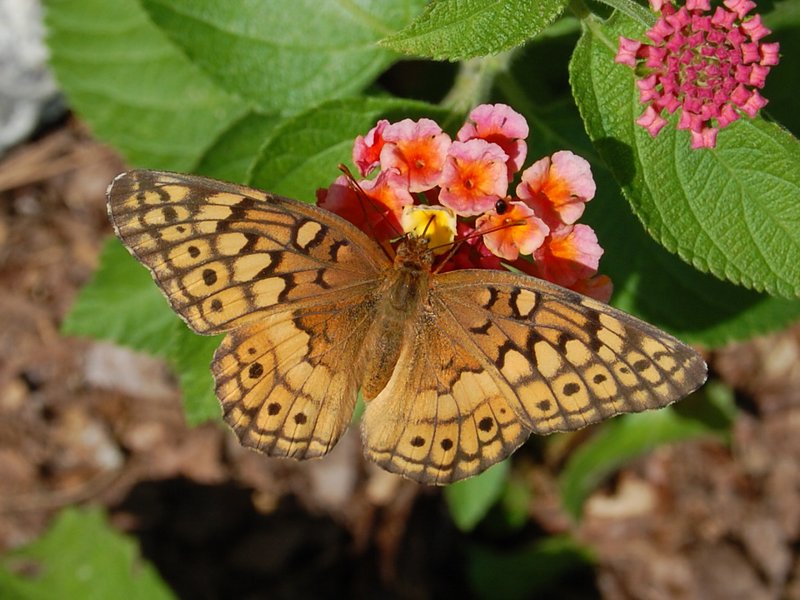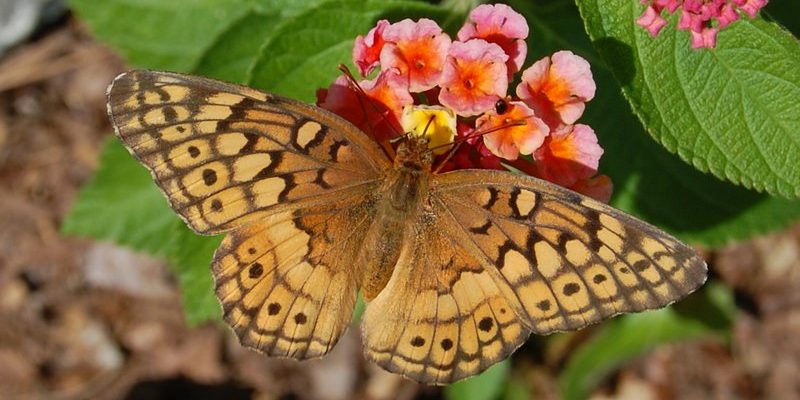
Have you ever marveled at the delicate beauty of butterflies fluttering through gardens? One stunning example is the Variegated Fritillary Butterfly. This vibrant creature not only captivates with its colorful wings but also plays a vital role in our ecosystem. The Variegated Fritillary, with its intricate patterns and striking hues, is like nature’s little artwork, painting the world with its presence.
The Variegated Fritillary Butterfly is not just a pretty face. It belongs to the Nymphalidae family, which includes many other beautiful butterflies. This species is often found in open fields, meadows, and gardens, where it dances gracefully among the flowers. If you’re curious about its life cycle or habitat, you’re in for a treat. Let’s explore everything there is to know about this fascinating butterfly.
Physical Characteristics
The Variegated Fritillary Butterfly boasts a stunning appearance. Its wings display a mix of orange and black, creating a striking pattern that’s easily recognizable. Adult butterflies typically have a wingspan of about 2 to 3 inches, making them a medium-sized butterfly. The upper wings are a vibrant orange adorned with dark spots, while the underwings are more muted, showcasing a lovely pattern of browns and tans that helps them blend into their surroundings.
One of the most captivating features of these butterflies is their sexual dimorphism. Males and females can look quite different. Males often have brighter colors, which attract potential mates, while females tend to have slightly duller hues that help them camouflage, especially during egg-laying. It’s fascinating how nature equips these butterflies with unique traits that aid in their survival and reproduction.
Table of Facts
| Wingspan: | 2 to 3 inches |
| Habitat: | Open fields, meadows, and gardens |
| Diet: | Nectar from various flowers |
| Lifespan: | About 2 to 4 weeks |
| Flight Speed: | Up to 10 miles per hour |
| Range: | North America |
Life Cycle of the Variegated Fritillary Butterfly
The life cycle of the Variegated Fritillary Butterfly is nothing short of remarkable. Like all butterflies, they undergo a complete metamorphosis—a journey from egg to caterpillar (larva), and then to pupa (chrysalis) before becoming the beautiful adult butterfly we recognize. This transformation is a stunning display of nature’s magic.
It all starts when a female Variegated Fritillary lays her eggs on the leaves of specific host plants, primarily violets. These leaves are crucial for the caterpillars, as they serve as the primary food source once they hatch. After about a week, the tiny caterpillars emerge, ready to munch away. As they grow, they molt several times, shedding their skin and increasing in size. This process can be quite a sight!
Once the caterpillar has absorbed enough nutrients, it enters the pupal stage, where it forms a protective shell. Inside this chrysalis, the caterpillar undergoes substantial changes, reorganizing into its final form. After a few weeks, the adult butterfly emerges, often resting for a moment before taking its first flight. This entire life cycle showcases the incredible resilience and beauty of the Variegated Fritillary Butterfly.
Habitat and Distribution
The Variegated Fritillary Butterfly is commonly found throughout North America, particularly in regions with abundant wildflowers. They thrive in open meadows, prairies, and gardens where flowers bloom generously. If you live in an area with diverse plant life, there’s a good chance you might spot this butterfly flitting about.
These butterflies prefer habitats that provide not just food but also places to lay eggs, making flowers and host plants essential. When the weather warms up, and the flowers start to blossom, the Variegated Fritillary emerges, eager to enjoy the nectar from those colorful blooms. They are often seen basking in the sunlight, soaking up warmth before embarking on their search for food.
Interestingly, the Variegated Fritillary’s habitat preferences can vary depending on their life stage. While adults are drawn to blooming flowers for nectar, caterpillars seek out the leaves of violets to munch on. So, creating a garden that caters to both stages can attract these delightful butterflies to your yard.
Diet and Feeding Habits
When it comes to food, the Variegated Fritillary Butterfly has a sweet tooth for nectar. They absolutely love flowers and are often seen hovering around blooms, sipping nectar through their long proboscis. Think of their proboscis as a straw, which they use to slurp up delicious flower juices. Some of their favorite flowers include coneflowers, daisies, and goldenrods.
Interestingly, the dietary preferences of the Variegated Fritillary vary slightly during different life stages. As caterpillars, they have a more specific diet, primarily feeding on the leaves of violets. These plants provide not just nourishment but also a safe place to hide from predators. The caterpillars may be small, but they are savvy, often blending into the leaves to avoid becoming a meal for birds or other hungry creatures.
One fascinating observation is how these butterflies can often be seen darting about, engaging in a form of “nectar robbing.” This behavior occurs when they access nectar from flowers that other pollinators have already visited. By doing this, they may sometimes bypass the flower’s traditional feeding method, showcasing their adaptability in the wild.
Behavior and Social Structure
The Variegated Fritillary Butterfly is known for its vibrant behavior and social dynamics. During the warmer months, these butterflies are quite active, darting from flower to flower in search of food. They have a penchant for basking in the sun, which helps them regulate their body temperature and provides a perfect view to spot potential mates or predators.
When it comes to social interactions, Variegated Fritillaries are generally solitary creatures. However, during mating season, males become more visible and may establish territories to attract females. They can often be seen fluttering around, engaging in aerial displays to woo potential mates. It’s a little like a dance-off in the air, where the males showcase their colors and agility to impress the ladies.
Another interesting behavior is how these butterflies often engage in a form of territoriality. Males may be seen chasing away other males who venture too close to their claimed area. This instinctive behavior ensures that they maintain access to resources and mates, enhancing their chances of reproduction.
Threats and Conservation
Like many butterfly species, the Variegated Fritillary Butterfly faces a variety of threats. Habitat loss is one of the main challenges they encounter as urbanization and agricultural development reduce the availability of their preferred landscapes. When fields are replaced by concrete or are treated with pesticides, the delicate balance of their ecosystem is disrupted, making survival more difficult.
Climate change is another growing concern. Changes in temperature and weather patterns can affect the availability of food sources and suitable habitats. For instance, if flowers bloom earlier due to warmer temperatures, it may create a mismatch with the lifecycle of the Variegated Fritillary, impacting their feeding and reproduction.
Conservation efforts are essential to help protect these beautiful butterflies. Planting native flowers that attract them, as well as conserving their natural habitats, can make a significant difference. You can play a role in their preservation by creating butterfly-friendly gardens that provide food and shelter, helping to maintain the populations of Variegated Fritillary Butterflies for future generations to enjoy.
FAQ
What is the lifespan of a Variegated Fritillary Butterfly?
The lifespan of a Variegated Fritillary Butterfly generally ranges from about 2 to 4 weeks. However, factors like environmental conditions and availability of food can influence their lifespan. Under favorable circumstances, some butterflies may live slightly longer, particularly if they enter a period of dormancy or if temperatures remain mild during their active season.
How can I attract Variegated Fritillary Butterflies to my garden?
To attract Variegated Fritillary Butterflies to your garden, focus on planting a variety of nectar-rich flowers and host plants. They particularly love coneflowers, black-eyed Susans, and violets. Creating a sunny space with plenty of blooms throughout the growing season will encourage these butterflies to visit. Additionally, minimizing pesticide use will help ensure a safe environment for them.
Are Variegated Fritillary Butterflies harmful to plants?
No, Variegated Fritillary Butterflies themselves are not harmful to plants. In fact, their caterpillars primarily feed on the leaves of violets and are often considered a part of the ecosystem. The presence of these butterflies can indicate a healthy environment, as they contribute to pollination and the overall health of the plants in your garden.
Do Variegated Fritillary Butterflies migrate?
Unlike some butterfly species, Variegated Fritillary Butterflies do not typically migrate over long distances. They tend to remain within their general habitat range, although they may move to find food sources or suitable environments. Factors like weather and seasonal changes can influence their movements, but migration is not a common behavior for them.
What do Variegated Fritillary Butterflies do during the winter?
During winter, most adult Variegated Fritillary Butterflies enter a state of dormancy or hibernation to survive the cold months. They often seek shelter in protected areas, such as under leaves or in crevices, where they’ll remain inactive until the temperatures rise again in spring. The timing of their emergence can vary based on climate and local conditions.
How can I identify a Variegated Fritillary Butterfly?
Identifying a Variegated Fritillary Butterfly is relatively straightforward due to its distinctive coloring. Look for vibrant orange wings with dark spots for adults. The females tend to be slightly duller than the males. Observing their flight pattern can also help; they are known for their graceful, fluttering flight and often rest with their wings closed, showcasing the beautiful patterns on their underwings.
Are Variegated Fritillary Butterflies endangered?
Currently, Variegated Fritillary Butterflies are not classified as endangered, but like many species, they face challenges from habitat loss and climate change. Conservation efforts aimed at preserving their natural habitats and supporting butterfly-friendly environments are crucial in ensuring their continued presence in the wild.
Can I raise Variegated Fritillary Butterflies at home?
Raising Variegated Fritillary Butterflies at home is possible and can be a fascinating project! Start by sourcing violet plants, as these serve as the primary food source for the caterpillars. You can collect eggs or caterpillars from the wild while ensuring that you follow local regulations regarding wildlife conservation. Provide a safe environment with plenty of food, and you’ll be able to witness their incredible life cycle.

